The Perfect SMS Terms & Conditions Template (+6 Real Examples)
Find out what terms and conditions are, why you need them, and use our SMS/text terms and conditions template and examples to stay legally compliant.
Learn exactly what prior express written consent means and use our SMS consent templates and examples so you can comply with the TCPA for business texting.
In case you missed it (in which case you probably live under a rock), the digital world has been going through a bit of a privacy crisis over the past two or so years. There have been major changes with websites, ads, and emails…and now, text wants in.

Texting regulations are nothing new, but the enforcement of these regulations has been accelerating in recent months—the big one being that you are required to obtain prior express written consent before texting anyone. So what does that mean?
Read on to learn:
Disclaimer: Please note that this is not legal advice and is for informational purposes only. It is not intended to substitute for advice from qualified legal counsel, nor is it to assist you or help you be compliant as you assume 100% responsibility in all legal matters.
In plain speak, prior express written consent is a term in the Telephone Consumer Protection Act (TCPA) that means a consumer has granted you permission to call or text them.
What does that look like? Well, the TCPA’s definition of “prior express written consent” is as follows:
Before sending a marketing text or making a marketing call to consumers, the texter/caller must have the consumer's prior express invitation or permission, “which must be evidenced by a signed, written agreement between the consumer and seller, which states that the consumer agrees to be contacted by this seller and includes the telephone number to which the calls may be placed.”
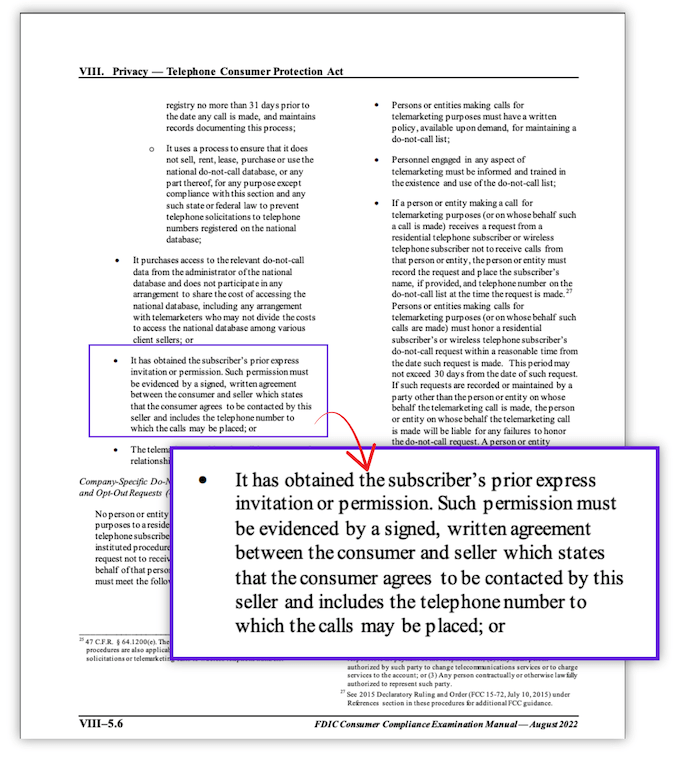
The CTIA (Cellular Telecommunications and Internet Association) also requires prior express written consent, by way of requiring businesses to adhere to the TCPA:
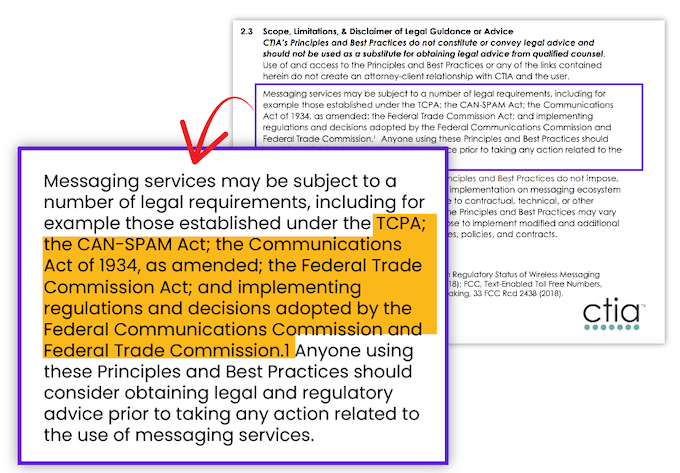
Let's break it down:
This needs to happen on any place on your website where you collect a visitor’s contact information for the purpose of reaching out to them via text.
Not only is this a legal requirement, but it stands to benefit your business to obtain prior express written consent.
All businesses sending texts to consumers must have that number registered with its appropriate third party (shortcode, toll-free, and 10DLC numbers each have different registration processes). Registration requires adherence to the TCPA as well as CTIA Messaging Principles and Best Practices both of which require SMS consent.
SMS consent is a way to protect consumers from being bombarded with excess and/or unwanted texts and calls. It is not actually a new regulation, but it is being newly enforced in the text realm as 10DLC regulations have ramped up.
10DLC stands for 10-digit long code, by the way. You can learn more about 10DLC here.
For the full history:
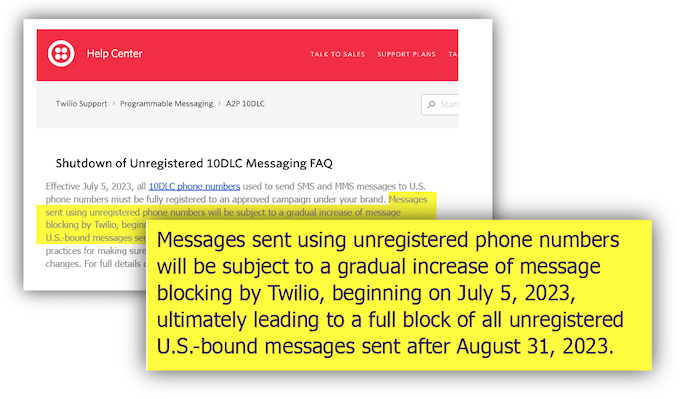
So, why are texting regulations ramping up? Because the goal of the rules is to protect consumer privacy and ensure a pleasant experience, and yet the number of unwanted and robotexts has been skyrocketing over the past few years.
From 2015 to 2022, the number of robotext complaints rose from 3,300 to 18,900—a more than 500% increase.
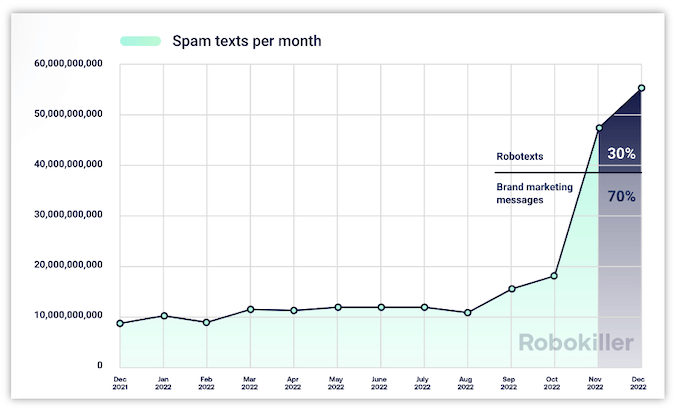
As a result, the FCC has recently begun stronger initiatives to crack down on texts from illegitimate numbers. No, your business may not be illegitimate and you aren’t sending spam texts, but unfortunately, the bad players in the industry have to ruin it for everyone. Blanket regulations have to be in place to keep things in check.
The explosion of robotexts isn’t the only factor at play here. As mentioned in the intro, the digital world is going through a privacy revolution right now. Consumers are extra vigilant of how their information is used and how and why they are contacted.
By following the ground rules, you can ensure protection against lawsuits—not to mention financial and reputation-related consequences, which we’ll talk more about later.
There are three ways to obtain prior express written consent for SMS: Form, text widget, or text opt in.
As a means of lead generation, with any offer from a business—such as to get an estimate, submit an inquiry, or download a guide—there is a form for the consumer to fill out to obtain it.
These can appear anywhere on your website, such as your contact us page, popups, landing pages, and live chat widgets. Anywhere where you collect their contact information is considered a form. Note that forms can also be offline, physical forms such as sign-up sheets in your store or at events.

Many home services businesses have a widget on the bottom right of their website that enables them to opt in to text communication.
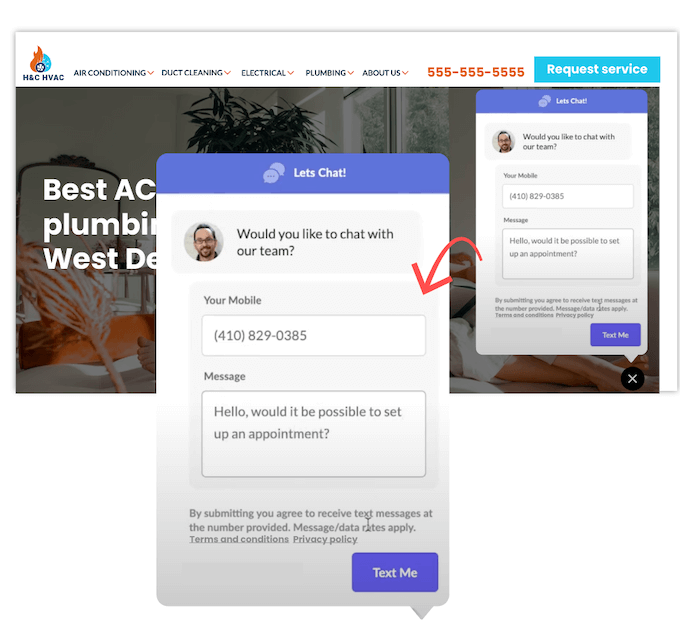
Many websites have offers to sign up directly to get updates, offers, and discounts through text. (Hatch Chat, for example)
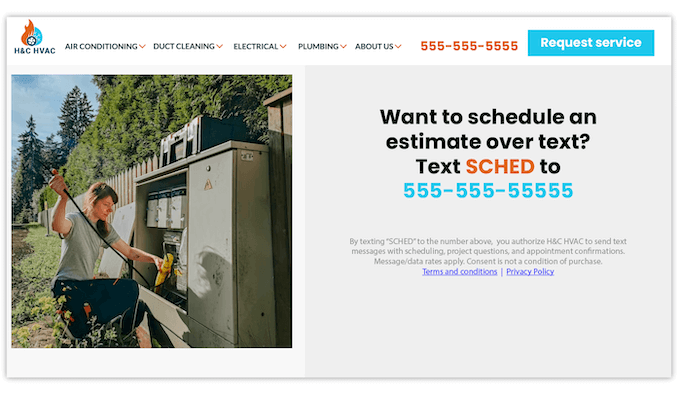
These two examples may appear simple, but they are actually meeting a long list of requirements for obtaining consent. Let’s go over them.
Regardless of which SMS consent method you are using, they are all considered an “agreement” and your agreement must contain the following:
Here are some examples of verbiage you can use in your forms and landing pages to obtain prior express written consent.
NOTE: This is not legal advice, but just meant to give you a starting point. Please clear these with your legal representative.
ALSO NOTE: Remember that they all require the following:
Note that "By submitting" can be replaced with anything that describes the action, like "By clicking [button name]," "By signing up," etc.
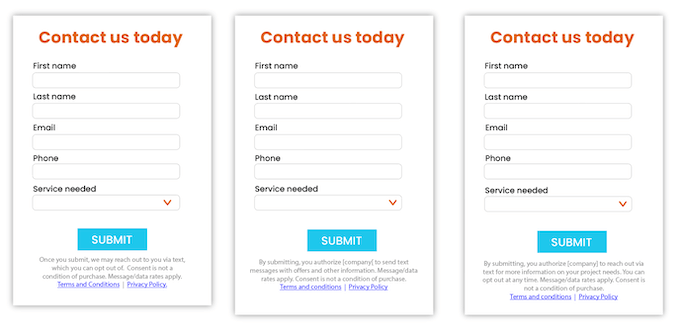
Checkbox examples:
These are optional, but we recommend using this especially if you use text in more of a conversational manner:
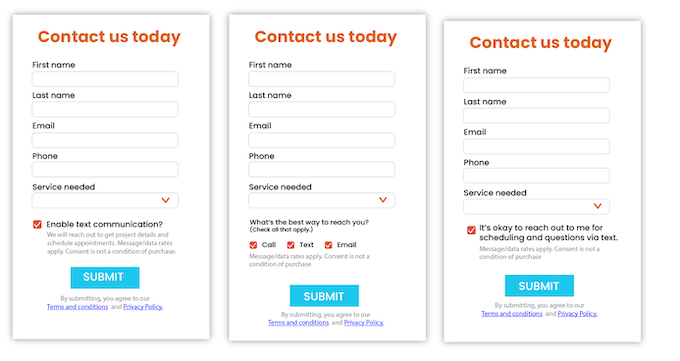
Other than staying compliant with the above TCPA and CTIA rules, there are a few more best practices that you can follow to ensure your reputation and rights are protected, and that you get the opt-ins you desire!
A double opt-in means you obtain consent in the form and then again via the first text you send. This is not required by the TCPA, but the CTIA recommends it if you’re sending recurring messages.
For example:

We get it—a well-designed website form needs a block of legal text like you need a hole in the head. Not only does it not look attractive, but legal stuff always runs the risk of scaring away a consumer. The problem is, you’ll only make things worse by trying to make it extra small or trying to reword it to sound less legal.
Stick to the verbiage required. If your website, content, and customer experience are all in top shape, you’ll have earned enough trust for consumers to feel comfortable opting in. Plus, at the end of the day, you only want to be texting consumers who want to be texting with you.
RELATED:
If your business uses text in a more conversational manner, don’t be afraid to explore your options and find the messaging that works best for you.
For example, Hatch customers primarily use business texting to converse with customers in real time. This is very different from, say, an ecommerce business sending texts with promo codes once a week.
As such, we recommend different verbiage than what is suggested (after clearing it with compliance). For example:
There are so many factors involved in whether a person converts on your forms and landing pages. While you can’t control the legal aspect of things, there are still plenty of elements you can test to find out what works best: the images, the copy, the button color, the messaging, the layout of the page, and more. Run A/B tests on these elements so you can ensure that everything is in optimal conditions for conversion.
Check out my post on WordStream for more landing page tips:

Even though there is specific verbiage to be used for SMS opt-ins, there is still enough opportunity to make it conversational—which can help offset the rigid legalese.
For example:
Think about how you would talk to a friend and use that tone in your forms.
The TCPA is federal law, and its guidelines are in place to keep texting a win-win for both consumers and businesses. Here are five key reasons you need to take express written consent seriously:
Let’s finish off with an overall checklist for SMS opt-in requirements per the TCPA.
Create an SMS terms and conditions page or add an SMS section to your current terms and conditions page. It must include:
Create an SMS privacy policy page or add an SMS section to your current privacy policy page. It must:
Anywhere that you collect a consumer’s phone number for the purpose of reaching out to them via text, you must include the following on that form:
Many of these resources are already linked in the above article, but here is a list of them for easy reference.
From Hatch
Find out what terms and conditions are, why you need them, and use our SMS/text terms and conditions template and examples to stay legally compliant.
Learn about SMS, MMS, and TCPA compliance for effective text message marketing. Obtain consent, provide opt-out options, and keep accurate records.
Learn exactly what the new FCC one-to-one consent rule is, how it impacts lead generators and lead buyers, and what you need to do.
Be the first to know about new sales and marketing insights to grow your messaging strategy with leads and customers.